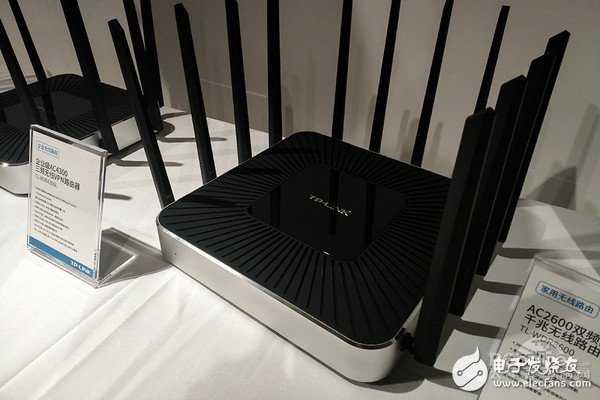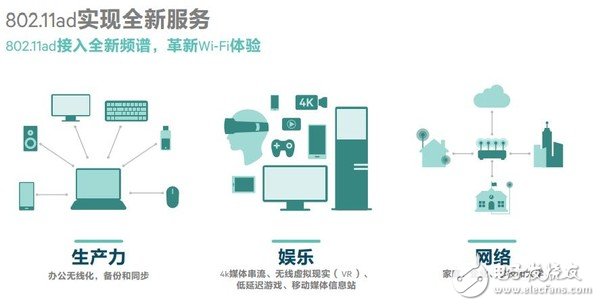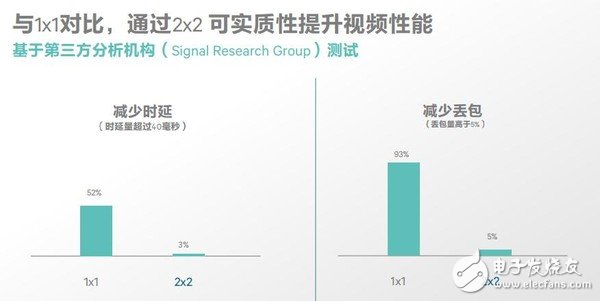With the development of the Internet and hardware terminals, there are more and more people using wireless networks in homes and public places. This will inevitably lead to data and bandwidth congestion. In the new era, wireless networks should extend bandwidth and network. Make new demands. As the leader in global wireless technology, Qualcomm is also how to solve the contradiction between the increase in demand and the inability of WiFi supply to keep up with changes.

TP-LINK routing based on Qualcomm platform exhibited at the salon
New 802.11ac tri-band platform for home networks
Qualcomm's new 802.11ac tri-band solution combines two 5GHz bands and a 2.4GHz band to achieve greater flexibility through the use of wireless spectrum and capacity by routers or repeaters.
In a home with multiple WiFi technologies, the router can specify a 2.4GHz band for traditional terminals (like old phones, laptops, etc.) to ease network congestion and ensure new terminals (support 802.11) Ac) Use a more stable bandwidth.
In addition, in a distributed network, the third band (5 GHz) provides a dedicated link for the range of expanders, helping to extend the range of mesh nodes.
In terms of specific solutions, Qualcomm provides two new tri-band platforms, both of which use the latest 802.11ac SOC, IPQ40x9. The IPQ40x9 can be combined with Qualcomm's new dual-stream 802.11ac band QCA9886. The new routers offer up to 2.2 Gbps of aggregation capability, and when combined with the quad-stream 802.11ac QCA9984, the aggregation capacity is as high as 3.1 Gbps.
WiFi SON (Self-Organized Network) Solution - Simplify Operational Optimization Experience
In addition, Qualcomm also launched a WiFi SON (Self-Organized Network) solution, which is designed to simplify home and office WiFi networks, making home network installations simpler, safer and automatically optimized. The main features of this technology include:
1. Self-configuration: support plug and play layout
2. Self-management: providing independent performance optimization
3. Self-repair: proactively detect and resolve connection barriers
4. Self-defense: to ensure that the network is protected from unauthorized access

Currently, WiFi SON has been integrated into the product, enabling OEMs to implement differentiated services. The technology currently supports Qualcomm's HomePlug AV2 power line solution, enabling seamless connectivity between home wired and wireless networks.
In the future, WiFi SON technology will work with more OEMs to support smart gateways, wireless routers, expanders and access points.
Milestone 802.11ad products to build a multi-band WiFi ecosystem
As terminal equipment demands more and more wireless network capacity and speed, products with multi-frequency WiFi function are very important. Multi-band WiFi includes 802.11ad in the 60GHz band and 802.11ac MU in the 2.4/5GHz band. MIMO function.

MU-MIMO is an abbreviation of "MulTI-User MulTIple-Input MulTIple-Output", that is, multi-user multiple input multiple output technology. It has evolved from the previous SU-MIMO (Single-User MulTIple-Input Multiple-Output) single-user multi-input and multi-input, which improves the transmission efficiency of the 11ac standard product. Compared with SU-MIMO, the MU-MIMO rate is increased by 2 times. .
Among them, 802.11ad can be used for delay-free docking station and screen mirroring, and 4K streaming for multi-terminal, close to instant multimedia access and fast upload/download. For 802.11ad, its throughput is its biggest advantage with the help of the 60GHz band. The peak code stream of the first generation of mass-produced 802.11ad chips can reach 4.6Gbps (the future will be higher), and because of the speed. It's faster, so the power consumption is lower than 802.11ac (because the time is shorter), and through FST (fast scene change), the terminal can switch between 802.11ad and ac, and the compatibility is better.

2x2 dual antenna WiFi, greater coverage
There are generally three ways to improve WiFi performance: 1. Spread spectrum, 2. Add antennas, 3. Increase coding efficiency. 1x1 is one antenna, which is responsible for transmitting and receiving Wi-Fi data, and 2x2 is two antennas, which can simultaneously receive data at the same time. The design of the dual antenna mainly improves the throughput and coverage. Compared with 1x1, the theory can increase the transmission and reception performance by about 3dB.
The third-party testing organization used 2x2 antenna and 1x1 antenna to compare the delay and packet loss rate. The test results show:

2x2 antenna WiFi has a 3% probability that the delay will exceed 40 milliseconds, while 1x1 antenna WiFi has a 52% probability that the delay will exceed 40 milliseconds.
2x2 antenna WiFi has a 5% probability of packet loss rate of 5%, while 1x1 antenna WiFi has a 93% probability of packet loss rate of 5%.
In addition, Qualcomm also simulated the user's use environment for testing, the test environment is a 100m? The 3 bedroom 2 hall home room, the load-bearing wall is a concrete cast structure, there are 15 WiFi interference around, the test selected WiFi is placed in the living room. The test point is the 24 test points in the room (including the living room, the corners of the surrounding room)
Coverage: 2x2 vs 1x1 (2.4GHz 802.11ac)

Coverage: 2x2 vs 1x1 (5GHz 802.11ac)

However, the internal space of the mobile phone is limited. How do you plug an antenna? To this end, Qualcomm also introduced a shared diversity antenna technology, which intelligently allocates the number of antennas through a switch to achieve 2x2 WiFi performance without occupying the internal space.
The cat7 Lan Cable are an eight-core Shield wire. Each pair has a Shield layer (commonly called a Foil Shield), and then a Shield layer (commonly called a Braided screen Shield) outside the eight cores, with the same connection as the RJ-45.The highest transmission frequency of the CAT7 Ethernet Cable S/FTP is 600MHz, and the transmission frequency of the CAT7 Network Cable is 1000MHz.
There are a number of significant differences between the six and seven cabling systems, the most obvious of which is bandwidth.The CAT6 cable of channels provide a comprehensive attenuation to crosspoint ratio of at least 200MHZ and an overall bandwidth of 250MHZ. CAT7 of systems can provide at least 500MHZ of comprehensive attenuation to crosspoking ratio and 600MHZ of overall bandwidth.
The proliferation of broadband applications has created a need for more bandwidth.For example, a typical CAT7 channel can provide a bandwidth of 862MHZ for the transmission of video signals, analog audio signals on another pair, and high-speed LAN information on a third or fourth pair.
Another difference between the CAT6 patch cable and cat7 patch cable systems is their structure.The six types of wiring systems can use either UTP or STP.The seven types of systems are based only on shielded cables.In the cat7 network cables, each pair has a shield layer, and four pairs of wires together have a common shield layer.In terms of physical structure, the additional shielding layer makes the CAT7 Ethernet Cable have a larger diameter.
Another important difference is its ability to connect hardware. The parameters of the cat7 patch cable of systems require that all pairs of wires provide at least 60DB of integrated proximal winding at 600MHZ.The cat6 systems only require 43dB at 100MHZ and 46dB at 250MHZ for the cat6 patch cable.

Cat 7 Ethernet Cord,Cat7 Lan Cable,Cat 7 Ethernet Cable,Cat 7 Network Card
Shenzhen Kingwire Electronics Co., Ltd. , https://www.kingwires.com